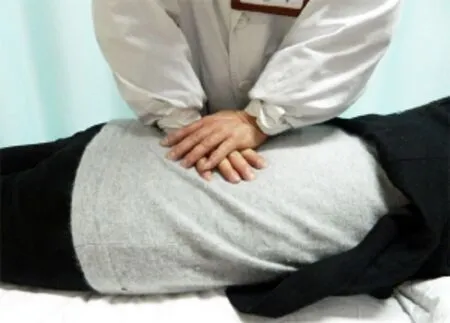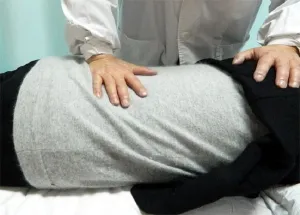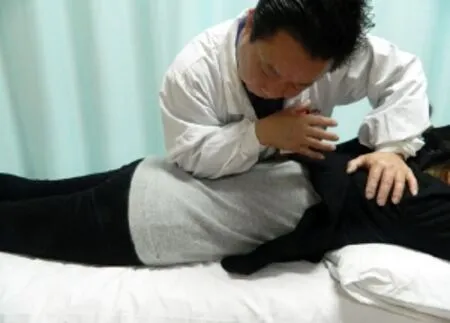A controlled study on treatment of acute lumbar sprain by acupuncture at Yaotongdian (EX-UE 7) plus tuina manipulation
2015-05-18YeJianguo叶建国
Ye Jian-guo (叶建国)
Qingpu Branch of Shanghai Zhongshan Hospital, Shanghai 201700, China
A controlled study on treatment of acute lumbar sprain by acupuncture at Yaotongdian (EX-UE 7) plus tuina manipulation
Ye Jian-guo (叶建国)
Qingpu Branch of Shanghai Zhongshan Hospital, Shanghai 201700, China
Objective:To observe the clinical effects of acupuncture at Yaotongdian (EX-UE 7) plus the oblique Ban-pulling manipulation for acute lumbar sprain.
Acupuncture Therapy; Point, Yaotongdian (EX-UE 7); Tuina; Massage; Low Back Pain; Sprains and Strains
Acute lumbar sprain refers to acute laceration induced by over traction of the soft tissues of muscular muscles, fascias and ligaments due to sudden external strength, and often occurs in moving and lifting heavy objects, when the lumbar muscles are contracted powerfully. Acute lumbar sprain can have the attachment of the lumbosacral muscles, periosteum and fascias and ligaments split, and the minor lumbosacral joints disturbed. The patients may present with low back pain and impaired movement, influencing the normal life and work.
Acupuncture[1-2]and tuina therapy[3-4]are the effective methods for acute lumbar sprain. In this study, the clinical effects of acupuncture plus tuina treatment for acute lumbar sprain were observed.
1 Clinical Materials
1.1 Diagnostic criteria[5]
With past history of lumbar sprain, mostly in young adults; with serious low back pain on one or both sides, limited motion, disability to turn, sit or walk, often in a forced position for reducing pain; lumbar or gluteal muscles spasm, or palpable cord-like hard lump, obvious tenderness in the injured part, and change in the physiological curve of the spine.
1.2 Inclusion criteria
In conformity with the diagnostic criteria of acute lumbar sprain; duration within 7 d; age within 65 years old; willing to participate in and signed the informed consent.
1.3 Exclusion criteria
Surgery of lumbar vertebrae or with fixed steel plate for the lumbar vertebrae; tumor or tuberculosis in the lumbar vertebrae; and intraspinal cysts.
1.4 Statistical methods
All data were processed by SPSS 15.0 software. The measurement data were expressed by mean ± standard deviationand processed witht-test. The counting data were processed by Chi-square test.P<0.05 expresses a statistical significance in difference.
1.5 General data
Totally, 180 cases of the patients were recruited and divided into two groups by drawing lots (note: originally there were 90 cases in each group, but eight cases in the control group requested to participate in the treatment group. Therefore, there were 98 cases in the observation group and 82 cases in the control group). Of 98 cases in the observation group, the age ranged from 17 to 63 years old, and the duration ranged from 45 min to 7 d. Of 82 cases in the control group, the age ranged from 22 to 65 years old, and the duration ranged from 2 h to 7 d. By statistical management, the differences of the general data between the two groups were not statistically significant (P>0.05), indicating that the two groups were comparable (Table 1).

Table1. Comparison of general data between the two groups
2 Therapeutic Methods
2.1 Observation group
2.1.1 Acupuncture treatment
Acupoints: Bilateral Yaotongdian (EX-UE 7).
Method: The patient took a sitting position. Disposable sterile filiform needles of 0.30 mm in diameter and 25-40 mm in length were selected. After the skin was disinfected routinely, the bilateral Yaotongdian (EX-UE 7) were punctured perpendicularly. Even reinforcing-reducing manipulation was performed after arrival of the needling sensation, such as local sore and swollen sensation. After pain was alleviated, the patient was told to stand up, with the two feet separate as wide as the shoulder (or a little bit wider), to swing the waist forward, leftward, backward and rightward, and then turn by the opposite direction, or two directions in alternation. After pain was relieved, the patient was told to bend forward and backward, squat down and stand up, bend forward and backward, with the increasing amplitude. Those who were unable to sit because of severe pathological situation could lie on PT bed for acupuncture and then turn over on the bed with the increasing amplitude. After pain was somewhat alleviated, they could stand up and do the lumbar action. During the treatment, the needles could be manipulated for several times, to intensify the needling sensation. After the patient moved more freely, the patient took a prone position on the table for tuina treatment.
2.1.2 Oblique Ban-pulling manipulation
The patient took a prone position on the treatment bed. First, Gun-rolling manipulation was applied to the lumbar and painful region for 10 min (Figure 1), followed by An-pressing (Figure 2), Rou-kneading (Figure 3), Ca-chafing (Figure 4), and Pai-patting (Figure 5) for 10 min; finally, by the bilateral oblique Ban-pulling manipulation (Figure 6). The result would be better if a‘cracking’ sound was heard[6-8].

Figure 1. Gun-rolling manipulation

Figure 2. An-pressing manipulation

Figure 3. Rou-kneading manipulation

Figure 4. Ca-chafing manipulation

Figure 5. Pai-patting manipulation
2.1.3 Course of treatment
The treatment was given once per day, continuously for three sessions. The therapeutic effect was observed after three sessions.
2.1.4 Cautions
The patient was told to have rest in bed for 2-3 h, and to avoid bending forward and heavy load in the recent period (2-3 d).

Figure 6. Oblique Ban-pulling manipulation
2.2 Control group
The patients in the control group were only treated by the same oblique Ban-pulling manipulation as those in the observation group, with the same manipulation, course and cautions.
3 Results
3.1 Criteria of therapeutic effects
The therapeutic effects were defined in reference to the criteria of the therapeutic effects for acute lumbar sprainin Shanghai Diagnostic and Therapeutic Guidelines of Traditional Chinese Medicine[5].
Cure: Low back pain disappeared, with normal spinal activity.
Improvement: Low back pain decreased, with basically normal spinal activity.
Failure: No alleviation in the symptoms.
3.2 Therapeutic results
The total effective rate was 100% and the curative rate was 98.0% in the observation group. The total effective rate was 97.6% and the curative rate was 92.7% in the control group. In comparison of the curative rate and the total effective rate between the two groups, the differences were not statistically significant (P>0.05). The curative rate after the first treatment was 70.4% in the observation group versus 56.1% in the control group. The difference in the curative rate after the first treatment between the two groups was statistically significant (P<0.01), (Table 2).

Table 2. Improvement of symptoms in the patients of the observation group (case)
4 Experience
Acute lumbar sprain is mostly caused by obstruction of the meridians by stagnation of qi and blood, due to sudden contusion or improper force in uplifting heavy object[9]. Therefore, the treatment principles are to circulate qi, activate blood, dredge the collaterals and stop pain.
Acupuncture at Yaotongdian (EX-UE 7) and tuina are common methods for acute low back pain. But, there are not many reports about acupuncture at Yaotongdian (EX-UE 7) in combination with tuina techniques. Most reports about the treatment of this disease by puncturing Yaotongdian (EX-UE 7) did not give the detailed explanation on the therapeutic procedure, and in particular on those who were unable to stand or move due to lying down on the bed (taken into the clinic with the stretcher)[10-12]. Moreover, the course is generally longer in the treatment of acute lumbar sprain by puncturing Yaotongdian (EX-UE 7) alone, mostly over five sessions or even several weeks; and some patients are unable to load in the lumbar region and would be easy to suffer from repeated sprain after treatment. If acute lumbar sprain is treated by tuina techniques only, it will take 2-5 sessions or longer. But, during the treatment, those with serious low back pain are not easy to accept the treatment, influencing the therapeutic effects and course.
Therefore, acute lumbar sprain is treated by puncturing Yaotongdian (EX-UE 7) in combination with oblique Ban-pulling manipulation in the observation group in this study. Yaotongdian (EX-UE 7) is a specific effective acupoint for acute lumbar sprain, skillful in regulating qi and blood in the lumbar region. Acupuncture at Yaotongdian (EX-UE 7) can activate blood circulation, disperse blood stasis, soothe the tendons, activate collaterals, strengthen the low back and stop pain; in combination with flexing, extending and rotating movements during the retaining of the needles, it can gradually alleviate the lumbar spasm, increase the activity of the low back and correct the curvature of the lumbar vertebrae[13]. Oblique Ban-pulling manipulation has the effects to correct the anatomical abnormality and regulate the functions of Zang-fu organs. Acupuncture plus oblique Ban-pulling manipulation can correct the disturbance of the minor lumbar joints, dredge the meridians and collaterals, circulate qi and activate blood, so as to realize the purpose to cure acute lumbar sprain. The combination of the two methods can shorten the course, enhance the therapeutic effects, reduce the (therapeutic) pain during the treatment, and elevate the patient’s tolerance in the lumbar region, and effectively prevent the repeated lumbar sprain. It has been proven by the outcomes of this study that the differences are not statistically significant between the two groups in the total effective rates and curative rates, but the curative rate was obviously higher in the observation group than that in the control group, with statistical significance in the differences between the groups, indicating that the therapeutic effects appear faster in the observation group than in the control group.
In this study, I requested the patients with mild low back pain to take a sitting position, and then punctured Yaotongdian (EX-UE 7) and told the patient to bend forward and backward and gradually increase the amplitude, within the tolerance of low back pain. After low back pain was alleviated, the patient was told to take a standing position, to move the low back. For those patients unable to move and taken into the clinic with a stretcher were told to take a lying position first, after acupuncture at Yaotongdian (EX-UE 7), and were told to swing leftward and rightward slowly, and turn on the stretcher or PT bed, with the increasing amplitude, within the tolerance of pain in the low back. After pain was relieved, the patient was told to take a sitting position or a standing position to move the low back.
I found out that during tuina treatment, the patient’s muscular tension, pain degree and spinal curvature were obviously milder in the observation group than that in the control group. The patients in the two groups are mostly physical laborers, more females than males. This might be related to the laborer’s frequent loading activity of the low back. In addition to their job, the females also need to undertake lots of housework. Physical labor can influence the therapeutic effect. Therefore, the patients were told to have a bed rest at home for 2-3 h after treatment, in order to promote the effective restoration of the lumbar tissues, and avoid bending the body or heavy load in recent period (2-3 d). But, as soon as the symptom was alleviated, most patients devoted into their job or housework, often having the low back pain recurred, becoming chronic low back pain in some patients, and even inducing the lumbar intervertebral disc herniation in severe cases. Therefore, it is necessary to tell the patients to have a good rest and keep warm in the low back.
I also found out that quite a number of patients had a history of acute lumbar sprain or histories of lumbar sprains several weeks or several years before the visit. Because of lack of treatment or wrong treatment in the past, low back pain occurs repeatedly, especially after fatigue, heavy load, sneezing, cough or improper body posture, and accompanied by pain in the buttocks, lower limb, inguinal groove and lower abdomen on one side or two sides, etc. Those with a long duration can also present a numb sensation in the buttocks and leg on one side or two sides, similar to the manifestation of the lumbar intervertebral disc herniation. Therefore, it is necessary to tell the patient to have a CT scan or MRI examination, in combination with the pathogeny and clinical manifestations, in order to confirm the diagnosis and avoid mistakes.
Conflict of Interest
The author declared that there was no conflict of interest in this article.
Statement of Informed Consent
Informed consent was obtained from all individual participants included in this study.
Received: 25 November 2014/Accepted: 28 December 2014
[1] Wang HZ. Clinical observation of treatment of acute lumbar sprain by singular acupuncture at Yaotongdian (EX-UE 7). Bull Acad Mil Med Sci, 2010, 34(5): 499.
[2] Cao WM, Hao Y. Treatment of 59 cases of acute lumbar sprain by acupuncture plus cupping method. Guoji Zhongyi Zhongyao Zazhi, 2012, 34(3): 283-284.
[3] Wang LT, Zhan HS. Comparison of clinical effects of tuina and tuina plus digital oblique Ban-pulling manipulation for acute lumbar sprain. Chin J Sports Med, 2011, 30(8): 745-747.
[4] Peng T. Clinical effect of acupuncture and tuina for acute lumbar sprain and infrared imaging study. Yiyao Qianyan, 2014, 4(1): 35-36.
[5] Shanghai Municipal Health Bureau. Shanghai Diagnostic and Therapeutic Guidelines of Traditional Chinese Medicine. Shanghai: Publishing House of Shanghai University of Traditional Chinese Medicine, 1998: 273.
[6] Zhang QM, Fang M. Current situation about tuina treatment of acute lumbar sprain. Jingyaotong Zazhi, 2003, 24(4): 248-250.
[7] Liang ZX, Wang HL, Liu J. Observation on clinical effects of four-step tuina for acute lumbar sprain. Zhongguo Zhongyiyao Xinxi Zazhi, 2010, 17(11): 77-80.
[8] Lü R, Xie JW. Observation on clinical effects of the oblique pulling method plus balancing acupuncture for acute lumbar sprain. Nanjing Zhongyiyao Daxue Xuebao, 2009, 25(4): 311-312.
[9] Yan JT. Tuina Science. Beijing: China Press of Traditional Chinese Medicine, 2003.
[10] Han H, Li M. Observation on clinical effects of acupuncture plus sports therapy for acute lumbar sprain. Shizhen Guoyi Guoyao, 2012, 23(1): 244-245.
[11] Chen WF, Yu LH. Analysis of 37 cases of acute lumbar sprain treated by acupuncture plus lumbar movement. Zhongwai Jiankang Wenzhai, 2012, 9(41): 381.
[12] Li GY. Observation on effect of acupuncture at Yaotongdian (EX-UE 7) in treatment of acute lumbar sprain. Shiyong Zhongyiyao Zazhi, 2008, 24(5): 305.
[13] Zhou JH, Wu YC, Sun YJ, Huang CF. Observations on the efficacy of Houxi-to-Hegu acupuncture plus lumbar activities in treating acute lumbar sprain. Shanghai Zhenjiu Zazhi, 2011, 30(6): 405-406.
Translator:Huang Guo-qi (黄国琪)
针刺腰痛点结合推拿治疗急性腰扭伤的对照研究
目的:观察针刺腰痛点结合推拿斜扳法治疗急性腰扭伤的临床疗效。方法:将 180例患者按抓阄法分成观察组和对照组。观察组98例,采用针刺腰痛点(EX-UE 7)及推拿斜扳法治疗; 对照组82例, 仅采用推拿斜扳法治疗。两组连续治疗3次后观察疗效。结果:观察组治愈96例, 好转2例; 治愈率98.0%, 总有效率100%。对照组治愈76例, 好转4例, 无效2例; 治愈率92.7%, 总有效率97.6%。两组治愈率及总有效率比较, 差异均无统计学意义(P>0.05); 但治疗第1次后观察组痊愈率高于对照组, 两组差异有统计学意义(P<0.05)。结论:针刺腰痛点结合推拿斜扳法与单纯推拿斜扳法治疗急性腰扭伤疗效相当, 但前者起效较快。
针刺疗法; 穴, 腰痛点; 推拿; 按摩; 腰痛; 扭伤和劳损
R246.2 【
】A
Author: Ye Jian-guo, bachelor, associate chief physician.
E-mail: qpyejianguo@gmail.com
Methods:A total of 180 patients were divided into an observation group and a control group by drawing lots. The 98 cases in the observation group were treated by puncturing Yaotongdian (EX-UE 7) plus the oblique Ban-pulling manipulation. The 82 cases in the control group were only treated by the oblique Ban-pulling manipulation. After the two groups were treated continuously for three sessions, the therapeutic effects were observed.
Results:In the observation group, 96 cases were cured and 2 cases were improved; the curative rate was 98.0% and the total effective rate was 100%. In the control group, 76 cases were cured, 4 cases were improved and 2 cases failed; the curative rate was 92.7% and the total effective rate was 97.6%. In comparison of the curative rate and total effective rate, the differences were not statistically significant (P>0.05). But, the curative rate after the first treatment was higher in the observation group than that in the control group, with a significant difference between the two groups (P<0.05).
Conclusion:The therapeutic effects were similar by acupuncture at Yaotongdian (EX-UE 7) plus oblique Ban-pulling manipulation and by single oblique Ban-pulling manipulation for acute lumbar sprain. But, it took effect quickly by puncturing Yaotongdian (EX-UE 7) plus the oblique Ban-pulling manipulation.
猜你喜欢
杂志排行
Journal of Acupuncture and Tuina Science的其它文章
- Efficacy observation on acupuncture-moxibustion for urinary retention after surgery for cervical cancer
- Therapeutic observation of acupuncture plus heat-sensitive moxibustion for chronic pelvic inflammatory disease
- Effect of complex reinforcing-reducing manipulation on lower limb motion and balance disorder in patients with subacute combined degeneration of the spinal cord
- Clinical study on skin needling plus heat-sensitive moxibustion for chronic facial paralysis
- Effect of tuina manipulations on blood pressure and its variability in hypertension patients
- Clinical study on acupoint massage in improving cognitive function and sleep quality of elderly patients with hypertension
